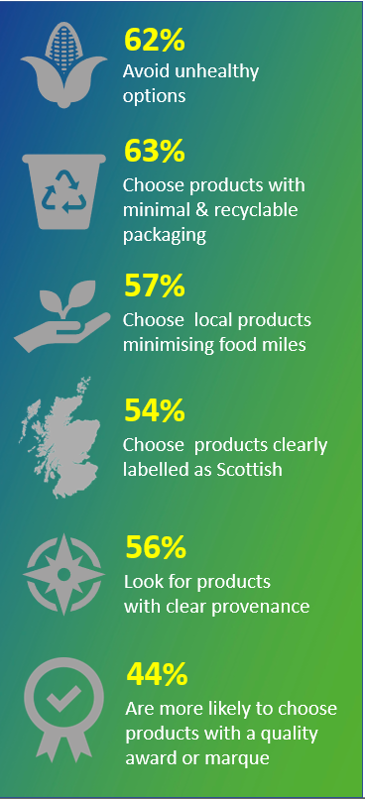20 December 2019
What’s in store for the Scottish food and drink sector in 2020?
The Scottish food and drink industry contributes a massive £14 billion per year to Scotland’s economy – one of the most significant contributors which places it as a key growth sector in the Scottish Government’s Economic Strategy. This also reflects its contribution to employment with almost 19,000 individual food and drink businesses in Scotland employing over 115,000 people! But things are constantly changing – consumer needs and behaviours, the retail landscape and Government legislation. What’s in store for 2020?
What sets the Scottish food and drink sector apart?
The Scottish market is unique making it a challenging but also an exciting place for food and drinks producers. While spending a similar amount on groceries as those living elsewhere in the UK, the Scottish household shops differently. Research undertaken by Kantar Worldpanel has shown that Scots make an additional 28 shopping trips per year compared with the UK average, but they spend less on each shopping occasion. This tends to reflect the unique retail structure in Scotland.
Kantar data shows that where Scots shop is changing too. The discounters are making their mark – with Aldi and Lidl both outperforming the wider market. Collectively the discounters gained around 1% of market share over the last 12 months (£126 million of sales through the tills) and with more store openings planned, their rise looks set to continue.
Scottish consumers have typically been more loyal to brands than is the case elsewhere in the UK – a reflection of the greater proportion of older shoppers in Scotland. Although this remains the case (Scots shoppers spent £164 more on brands per person than the average in Britain during 2018), there is evidence of a shift in the balance towards own label. This reflects trends elsewhere in the UK but own label growth in Scotland is not just about shoppers seeking cheaper options – the fastest growing own label tier in Scotland includes premium ranges.
Trends and challenges
The food and drink sector is continually evolving. And there are many developments and trends which while challenging, will also provide opportunities for the sector:
Health & Wellbeing
The search for the healthier option has become much more prevalent in recent years and continues to evolve – Kantar research shows that three quarters of Scots have an ambition to live a healthier lifestyle. Consequently, consumers are much more likely to pay attention to ingredients – not just calorific content but also artificial flavourings, sugar and unsaturated fat. Recent research undertaken on Kantar’s Scottish omnibus survey for 56 Degree Insight showed that 62% of Scots actively avoid unhealthy options when food shopping. Scots are undoubtedly drinking less in recent years – the recent Minimum Unit Pricing legislation appears to be having an impact with a reduction in volume of take-home alcohol bought overall, and drinkers paying more for what they do imbibe. In addition to this, Kantar research shows that consumers are selecting smaller pack sizes and paying approximately £1 more per litre than their counterparts elsewhere in Britain. The non-alcoholic and low alcohol sector continues to grow at a faster rate than in the rest of Britain, as a growing proportion of the population looks to moderate their drinking habits.
Sustainability and environmental issues
As consumers become ever more aware of the environmental impact of their choices, brands will continue to look at ways to address these concerns. When it comes to packaging, many brands are addressing the need for it to be recyclable and reducing plastic use generally with increased use of biodegradable film. Retailers are also playing their part, with many looking at plastic-free fruit and vegetable aisles and offering paper bags instead of plastic. And this is important to Scots consumers – our recent survey of Scots showed that 63% are more likely to choose products which have minimal packaging and that it is recyclable. And of course, the Scottish Government has also outlined plans to introduce a Deposit Return Scheme for some plastic drinking containers, cans and glass. We have undertaken research amongst consumers which has shown broad support for this initiative as it reflects these increasing environmental concerns – though as always, its success – for both consumers and the food and drinks business will be determined by its implementation. This is an area where 56 Degree Insight will continue to monitor through consumer research over the coming months.
But sustainability is not just the packaging: Scots consumers are increasingly educated about how their everyday food choices can add up to a big impact on the environment, which has resulted in the rise of diets featuring less or no meat. Kantar research has shown that while vegetarians still make up just under 5% of the population, the number of flexitarians continues to rise, with about 1 in 10 households now containing someone who is actively reducing the amount of meat in their diet. And our recent survey also showed that there is greater awareness of how far that food had to travel to reach the supermarket shelf: 57% of Scots are more likely to choose local products to reduce the amount of ‘food miles’ in their product choices.
Provenance
Buying local brings us neatly to another key trend which has rising significance - ‘provenance’ - knowing where your food and drink comes from and how it is produced is increasingly important. Our recent survey showed that 56% of Scots factor this in as part of their buying decision. This is often where telling the story of the product and the brand can be extremely effective. Several Scottish craft gin producers have used this approach effectively to draw customers in and develop an interest and intrigue about their brand. On a larger scale, the ‘family heritage’ story has been a mainstay of some of Scotland’s iconic food and drink brands from the likes of Baxter’s and Walker’s. This approach can be used to highlight the provenance of the product in an engaging way which can appeal to the consumer.
Scottishness and importance of locality
National identity has always been important to Scots – in the 2011 census, the identification of most Scots with being ‘Scottish’ rather than ‘British’ was evident. 62% of the total population stated their identity was ‘Scottish only’. And there is evidence that the degree of Scottishness is also important for many Scots when it comes to food and drink brands.
In mid-2019, 56 Degree Insight undertook research which explored how Scots felt about food and drink branding some 3 years’ on from the decision by Tesco to change the branding of their strawberries and replace the Scottish saltire on the packaging with the union flag. We asked Scots when faced with a direct choice of two identical food items but one with a UK flag and labelled ‘100% British product’ and the other with a Scottish flag and labelled ‘100% Scottish product’, which would you they be more likely to buy? The results provided a clear direction to food manufacturers and retailers when selling Scottish produce within Scotland – the importance of using Scottish branding was clear: 56% would choose the product branded ‘Scottish’ whereas only 4% would choose the ‘British’ labelling. The remaining 39% were ambivalent, saying it would ‘make no difference’.
The importance of accreditation
We live in a world where awards and accreditations play a major role in consumer behaviours and decision-making. The Consumers Association have pioneered product comparisons and driven up best practice for many years and in every walk of life we see accreditation schemes and awards – from holiday accommodation quality assurance schemes to Blue Flag awards for beaches and coastline. And food and drink is no different – we asked Scots how important such awards were in food purchase: 44% said they were more likely to choose products with a quality marque or award.
Early in the New Year, we will share some exciting news about a new project we will be working on in the Food & Drink sector in Scotland in 2020. We can’t say too much at the moment, but we will certainly be releasing regular research and insight pieces over the coming months on consumer views and trends affecting the food and drinks business in Scotland. Watch this space!




